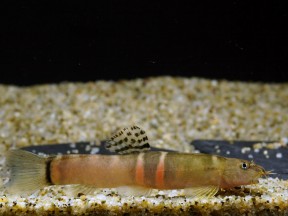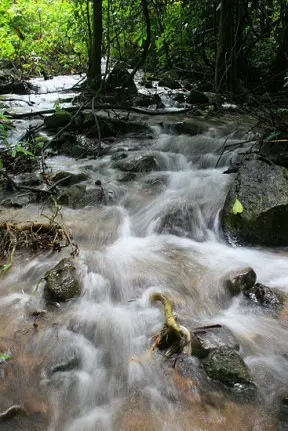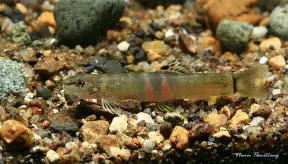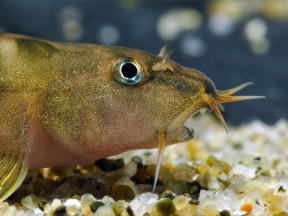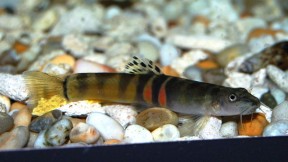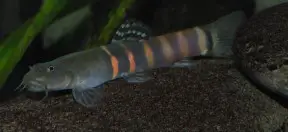Schistura cf. balteata
Sumo Loach II
Etymology
Schistura: from the Greek schizein, meaning ‘to divide’, and oura, meaning ‘tail’, in reference to the caudal-fin shape of many species.
Classification
Order: Cypriniformes Family: Nemacheilidae
Distribution
This apparently undescribed species has been collected from the Ataran River drainage, a tributary of the Salween River flowing through the states of Kayin and Mon, Myanmar, and the fish available in the trade are apparently sourced from the rivers’ headwaters in Kayin.
It also occurs in Sangkhla Buri district, Kanchanaburi province, western Thailand, where the Ataran is known as the Kasat.
There actually exist various populations of similarly-patterned fishes on both the Thai and Myanmar sides of the Tenasserim Mountain range, of which a handful have been described as S. aurantiaca, S. cincticauda, S. paucifasciata, and S. robertsi, respectively.
Habitat
Like most Schistura it inhabits clear, well-oxygenated, fast-flowing water around watersheds and headwaters. These are often shaded by forest cover with the substrate invariably composed of coarse sand, gravel, rocks, and boulders with no aquatic plants.
It also occurs in some particularly high-gradient streams, even cascades, with little marginal vegetation. During the dryer months of the year it survives in isolated, stagnant pools at some localities.
Thanks to Kamphol Udomritthiruj.
Maximum Standard Length
70 – 80 mm.
Aquarium SizeTop ↑
Even a small group will need an aquarium with base dimensions of 90 ∗ 30 cm or similar.
Maintenance
Not difficult to maintain under the correct conditions. We strongly recommend keeping it in a tank designed to resemble a flowing stream or river with a substrate of variably-sized rocks, sand, fine gravel, and some water-worn boulders.
This can be further furnished with driftwood branches arranged to form a network of nooks, crannies, and shaded spots, thus providing broken lines of sight.
While the majority of aquatic plants will fail to thrive in such surroundings hardy types such as Microsorum, Bolbitis, or Anubias spp. can be grown attached to the décor.
Once acclimatised individuals tend to select a particular cave or sheltered space which they defend against conspecifics and similar-looking species so it’s important to provide a well-structured environment.
In this kind of set-up it will thrive and can be kept alongside other species that enjoy similar conditions (see ‘Behaviour and Compatibility’).
Though torrent-like conditions are unnecessary it does best if there is a high proportion of dissolved oxygen and some water movement in the tank so power filter(s), additional powerhead(s), or airstone(s) should be employed as necessary.
Like many fishes that naturally inhabit running water it’s intolerant to accumulation of organic pollutants and requires spotless water in order to thrive. Weekly water changes of 30-50% tank volume should therefore be considered routine.
Water Conditions
Temperature: 22 – 26 °C
pH: Prefers weakly acidic to neutral water within the range 6.5 – 7.5.
Hardness: 36 – 215 ppm
Diet
Schistura species are omnivorous although the bulk of their diet consists of small insects, worms, crustaceans, and other zooplankton with only relatively small amounts of plant matter and other organic detritus consumed.
In the aquarium they will accept dried foods of a suitable size but should not be fed these exclusively.
Daily meals of small live and frozen fare such as Daphnia, Artemia, bloodworm, etc., will result in the best colouration and condition. In a set-up with moving water they will often shoot up to snatch morsels passing in the flow.
Behaviour and CompatibilityTop ↑
Not especially aggressive compared with some members of the genus but remains largely unsuitable for the general community aquarium due to its specialised requirements.
This is not to say it must be kept alone, rather that tankmates must be selected with care and proper research.
Slow-moving or long-finned species should certainly be omitted because they’re likely to struggle with the necessary level of water movement and may end up with nipped fins.
Placid bottom-dwellers such as Corydoras or Pangio spp. also tend to be easy targets for territorial Schistura and are best avoided.
Fishes which inhabit similar biotopes in nature, especially those which swim in open water such as Danio, Devario, Mystacoleucus, smaller Barilius, Pethia, Puntius, and Rasbora spp. constitute the best options, and one or two schools can make a visible difference to the confidence of this naturally reclusive loach.
Other possibilities include current-loving loaches from genera such as Pseudogastromyzon, Beaufortia, or Sewellia plus benthic cyprinids such as Crossocheilus and Garra spp.
Similarly-shaped relatives like Nemacheilus, Acanthocobitis, and other Schistura spp. aren’t recommended under most circumstances although a combination may work in larger aquaria.
While it can’t be described as gregarious a group can be maintained together provided the set-up contains plenty of rocky structures and broken lines of sight.
Occasional skirmishes may occur, however, and in small or sparsely-decorated tanks conspecific aggression may escalate to an unacceptable level.
Sexual Dimorphism
Young specimens can be tricky to sex accurately but mature males of Schistura species tend to possess noticeably enlarged ‘cheeks’; this being most obvious when the fish is viewed from above or head-on.
Females should be slightly thicker-bodied, especially when full of eggs.
Reproduction
As far as we are aware it’s not being produced commercially and all fish available in the trade are collected from wild stocks.
The digging of a cave beneath rockwork appears to be a precursor to spawning activity and has been observed on several occasions but to date only a single successful breeding report exists.
In 2007 a US aquarist recovered a number of fry from the canister of an external filter and later the main aquarium.
NotesTop ↑
This apparently undescribed species has been available in the hobby since around 2006 and has been traded under several trade names of which others include ‘tri-band sumo loach’ and ‘chubby loach’.
The name ‘Sumo II’ is now in wide use to distinguish it from the real S. balteata since both have been traded as ‘Sumo loach’.
Although they appear superficially similar S. sp. cf. balteata has brighter colouration, a smaller adult size, and seems more peaceful in nature. A number of other striped Schistura such as S. carbonaria may also be seen on sale under the ‘sumo’ nametag.
It’s highly variable in terms of colour pattern and there exist two generalised ‘forms’ based on the colour in the posterior half of the body with some specimens bright pink and others yellow.
These are said to occur sympatrically in nature and the differences in colour do not appear to infer gender or offer any competitive advantage, so the reason behind the phenomenon remains puzzling.
The intensity of body colour also varies depending on the specimen as does the number of light vertical body bars and pattern of black spots in the dorsal-fin.
Following Kottelat (1990) the real S. balteata is diagnosed by the following combination of characters: unique colour pattern consisiting of two dark vertical bars below the dorsal-fin; 3-5 pairs of round spots on the dorsal surface, anterior to the dorsal-fin; absence of black bar or marking at the caudal-fin base.
S. cf. balteata differs in that the vertical bars on the body are pink or yellow, and it possesses a dark bar extending across the entire caudal-fin base.
Schistura is the most species-rich genus among nemacheilid loaches with some 190 members and it continues to grow with over 100 having been described since 1990. It may represent a polyphyletic lineage and is often arranged into a number of loosely-defined species ‘groups’, some of which are quite dissimilar to one another.
Among these are an assemblage in which some or all of the body bars are vertically split and another which exhibit reductions in body size (adult size <50 mm SL), the number of pelvic and pectoral-fin rays and often the number of caudal-fin rays and lateral line length, for example.
Some species, such as S. geisleri, also appear to be unrelated to any of the others.
Most inhabit flowing streams or areas close to waterfalls where there naturally exist high concentrations of dissolved oxygen, and a handful are troglobytic, i.e., cave-dwelling, in existence. The latter have reduced pigmentation and are completely blind in many cases.
Schistura spp. are distinguished from other nemacheilids by a combination of morphological characters which include: a moderately arched mouth which is 2-3.5 times wider than it is long; a median ‘interruption’ in the lower lip which does not form two lateral triangular pads and can vary from smooth to furrowed in texture; diverse colour pattern but usually dark with relatively regular bars; usually a black bar at the caudal-fin base which can be broken into two spots or smaller bars; one or two black markings along the base of the dorsal-fin; lack of acuminate scales on the caudal peduncle; caudal-fin shape variable from truncate to forked but usually emarginate; presence or absence of a median notch in the lower jaw; clear sexual dimorphism in some species.
The family Nemacheilidae is widely-distributed across most of Eurasia with the Indian subcontinent, Southeast Asia and China representing particular centres of species diversity.
References
- Akan, F. E., T. T. Nalbant and S. C. Özeren, 2007 - Journal of Fisheries International 2(1): 69-85
Seven New Species of Barbatula, Three New Species of Schistura and a New Species of Seminemacheilus (Ostariophysi: Balitoridae: Nemacheilinae) from Turkey. - Kottelat, M., 1990 - Verlag Dr. Friedrich Pfeil, München: 1-262
Indochinese nemacheilines. A revision of nemacheiline loaches (Pisces: Cypriniformes) of Thailand, Burma, Laos, Cambodia and southern Viet Nam. - Kottelat, M., 2012 - Raffles Bulletin of Zoology Supplement 26: 1-199
Conspectus cobitidum: an inventory of the loaches of the world (Teleostei: Cypriniformes: Cobitoidei). - Plongsesthee, R., L. M. Page, and W. Beamish, 2011 - Ichthyological Exploration of Freshwaters 22(2): 169-178
Schistura aurantiaca, a new species from the Mae Khlong basin, Thailand (Teleostei: Nemacheilidae). - Tang, Q., H. Liu, R. Mayden, and B. Xiong, 2006 - Molecular Phylogenetics and Evolution 39(2): 347-357
Comparison of evolutionary rates in the mitochondrial DNA cytochrome b gene and control region and their implications for phylogeny of the Cobitoidea (Teleostei: Cypriniformes). - Šlechtová, V., J. Bohlen and H. H. Tan, 2007 - Molecular Phylogenetics and Evolution 44(3): 1358-1365
Families of Cobitoidea (Teleostei; Cypriniformes) as revealed from nuclear genetic data and the position of the mysterious genera Barbucca, Psilorhynchus, Serpenticobitis and Vaillantella.
